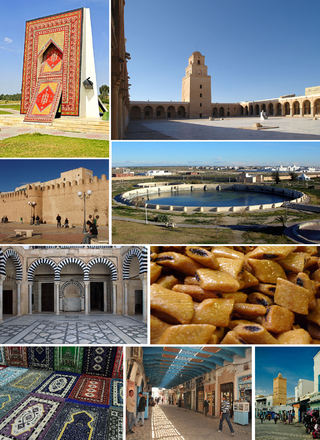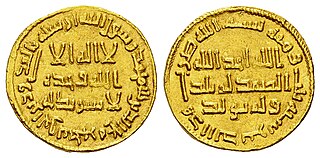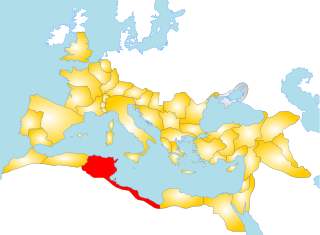Related Research Articles

Kairouan, also spelled El Qayrawān or Kairwan, is the capital of the Kairouan Governorate in Tunisia and a UNESCO World Heritage Site. The city was founded by the Umayyads around 670, in the period of Caliph Mu'awiya ; this is when it became an important centre for Sunni Islamic scholarship and Quranic learning, attracting Muslims from various parts of the world. The Mosque of Uqba is situated in the city.

Yazid ibn Abd al-Malik ibn Marwan, commonly known as Yazid II, was the ninth Umayyad caliph, ruling from 720 until his death in 724. Although he lacked administrative or military experience, he derived prestige from his lineage, being a descendant of both ruling branches of the Umayyad dynasty, the Sufyanids who founded the Umayyad Caliphate in 661 and the Marwanids who succeeded them in 684. He was designated by his half-brother, Caliph Sulayman ibn Abd al-Malik, as second-in-line to the succession after their cousin Umar, as a compromise with the sons of Abd al-Malik.
Hisham ibn Abd al-Malik ibn Marwan was the tenth Umayyad caliph, ruling from 724 until his death in 743.

Ifriqiya, also known as al-Maghrib al-Adna, was a medieval historical region comprising today's Tunisia and eastern Algeria, and Tripolitania. It included all of what had previously been the Byzantine province of Africa Proconsularis and extended beyond it, but did not include the Mauretanias.

ʿUqba ibn Nāfiʿ ibn ʿAbd al-Qays al-Fihrī al-Qurashī, also simply known as Uqba ibn Nafi, was an Arab general serving the Rashidun Caliphate since the reign of Umar and later the Umayyad Caliphate during the reigns of Mu'awiya I and Yazid I, leading the Muslim conquest of the Maghreb, including present-day Libya, Tunisia, Algeria and Morocco. He is credited with establishing Umayyad rule in North Africa. Uqba was the nephew of Amr ibn al-As. He is often surnamed al-Fihri in reference to the Banu Fihr, a clan connected to the Quraysh. His descendants would be known as the ʿUqbids or Fihrids.
ʿAbd al-Raḥmān ibn Ḥabīb al-Fihrī was an Arab noble of the Fihrid family, and ruler of Ifriqiya from 745 through 755 AD.
The Berber Revolt or the Kharijite Revolt of 740–743 AD took place during the reign of the Umayyad Caliph Hisham ibn Abd al-Malik and marked the first successful secession from the Arab caliphate. Fired up by Kharijite puritan preachers, the Berber revolt against their Umayyad Arab rulers began in Tangiers in 740, and was led initially by Maysara al-Matghari. The revolt soon spread through the rest of the Maghreb and across the straits to al-Andalus.

Abu al-Muhajir Dinar was a governor of Ifriqiya under the Umayyad Caliphate and lead the Muslim conquest of the Maghreb. He died in Tabuda after the Battle of Vescera in 683.
Hassan ibn al-Nu'man al-Ghassani was an Arab general of the Umayyad Caliphate who led the final Muslim conquest of Ifriqiya, firmly establishing Islamic rule in the region. Appointed by Caliph Abd al-Malik, Hassan launched a series of campaigns during the closing years of the 7th century, during which he defeated the Byzantines and the Berbers led by al-Kahina. The Byzantine capital of Carthage was destroyed in 698 and the nearby city of Tunis was founded in the following year. In Kairouan, Hassan set up a Muslim administration for the province to collect taxes from its Christian inhabitants and pay the troops. He enrolled thousands of Berbers into the army, which proved critical to later Muslim military successes in the Maghreb and the Iberian Peninsula. He was ultimately ousted from his post by the governor of Egypt, Abd al-Aziz ibn Marwan, due to a power struggle for influence over Ifriqiya.
The Battle of the Nobles was an important confrontation in the Berber Revolt in c. 740 AD. It resulted in a major Berber victory over the Arabs near Tangier Morocco. During the battle, numerous Arab aristocrats were slaughtered, which led to the conflict being called the "Battle of the Nobles". Zenata Berber chieftain Khalid ibn Hamid al-Zanati led the revolting Berber soldiers.
Habib ibn Abi Ubayda al-Fihri was an Arab military commander of the illustrious Fihrid family who played an important role in the early history of Ifriqiya (Tunisia) and al-Andalus (Spain).
The Battle of Bagdoura was a decisive confrontation in the Berber Revolt in late 741 CE. It was a follow-up to the Battle of the Nobles the previous year, and resulted in a major Berber victory over the Arabs by the Sebou River. The battle would permanently break the hold of the Umayyad Caliphate over the far western Maghreb, and the resulting retreat of elite Syrian forces into Spain would have implications for the stability of al-Andalus.
Handhala ibn Safwan al-Kalbi was an Umayyad governor of Egypt from 721 to 724 and again 737 to 742, and subsequently governor of Ifriqiya from 742 to 745.
Khalid ibn Abi Habib al-Fihri was an Arab military commander in North Africa during the Berber Revolt, who led the Arab army that was defeated at the Battle of the Nobles in late 740. The chronicles are oddly ambiguous on the biographical details of Khalid ibn Abi Habib. It is acknowledged that he was a member of the illustrious Fihrid family, descendants of the great Arab conqueror Uqba ibn Nafi al-Fihri. The patronymic structure suggests Khalid is the son of the father of Habib, which would imply that it is likely Khalid was the brother of Habib ibn Abi Ubayda al-Fihri, the principal military commander of Ifriqiya. But this is not confirmed.
Yazid ibn Abi Muslim was the Umayyad governor of Ifriqiya from 720 until his assassination in 721.
Mu'awiya ibn Hisham (Arabic: معاوية بن هشام, romanized: Muʿāwiya ibn Hishām; was an Arab general and prince, the son of the Umayyad Caliph Hisham ibn Abd al-Malik, who distinguished himself in the Arab–Byzantine Wars. His son, Abd al-Rahman ibn Mu'awiya, was the founder of the Emirate of Córdoba and the Umayyad line of al-Andalus.
Al-ʿAlāʾ ibn Mughīth, called variously al-Yaḥṣubī, al-Ḥaḍramī or al-Judhāmī, was the ʿAbbāsid-appointed governor of al-Andalus (Spain) in opposition to the Umayyads in AD 763.
The Battle of Al-Qarn was a military engagement between the Umayyad governor of ifriqya Handhala ibn Safwan al-Kalbi and the Sufrite Berber insurgents led by Oqasha ibn Ayub al-Fezari, the Umayyads were victorious in the bloody battle but withdrew after suffering heavy casualties.
Umayyad rule in North Africa or Umayyad Ifriqiya was a province of the Umayyad Caliphate (661–750) during the historical period in which it ruled the Maghreb region of North Africa, from its conquest of the Maghreb starting in 661 to the Kharijite Berber Revolt ending in 743, which led to the end of its rule in the western and central Maghreb. Following this period, the Umayyads retained their rule over Ifriqiya while the rest of the Maghreb fell to successive Islamic dynasties of Arab, Berber and Persian descent.
References
- ↑ Al-Nuwayri, p. 33
- ↑ Al-Nuwayri, p. 34
- ↑ Al-Nuwayri, Nihāyat al-arab fī funūn al-adab, Vol XXIV, p. 33
- ↑ Al-Nuwayri, p. 33
- 1 2 Blankinship, Khalid Yahya (1994-06-28). The End of the Jihâd State: The Reign of Hishām Ibn ʿAbd al-Malik and the Collapse of the Umayyads. State University of New York Press. p. 217. ISBN 978-0-7914-9683-1.
- ↑ Al-Nuwayri, p. 33
- ↑ Al-Nuwayri, p. 33-3
- ↑ Ahmad ibn Khalid an-Nasiri, al-Istiqsa li-Akhbar duwal al-Maghrib al-Aqsa Vol I, p. 169
- ↑ Ibn 'Idhari, Kitāb al-bayān al-mughrib fī akhbār al-Andalus wa-al-Maghrib, Vol I, p.89
- ↑ Al-Nuwayri, p. 34
- ↑ an-Nasiri, p. 170
- ↑ Ibn 'Idhari, p. 90